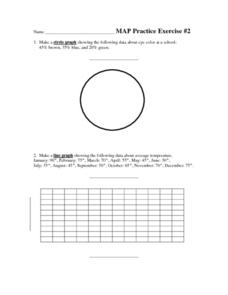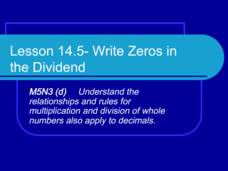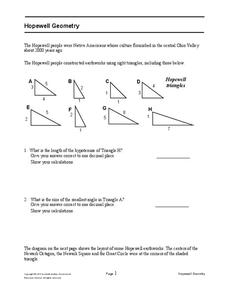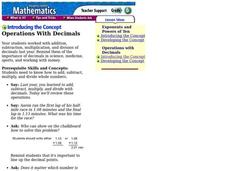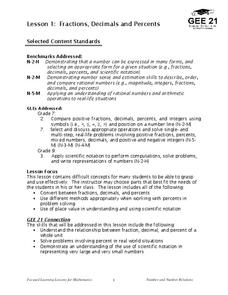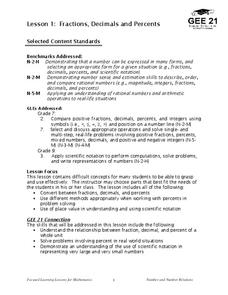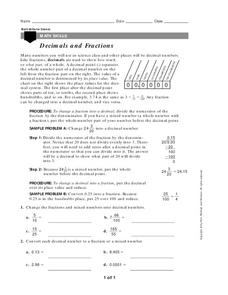BW Walch
Creating Linear Equations in One Variable
The example of two travelers meeting somewhere along the road has been a stereotypical joke about algebra as long as algebra has existed. Here in this detailed presentation, this old trope gets a careful and approachable treatment....
South Pasadena AP Chemistry
Acid-Base Equilibria: pH Practice
Across the top of the page is a large Z diagram representing varying degrees of acid-base equilibria. Advanced chemistry classes answer eight questions using the values listed for the H+ and the OH- ions that are part of the diagram and...
Penn Museum
Ancient History Math Mystery
Through several organized and attractive worksheets, your learners will make a deduction about tally marks and hieroglyphics to determine what they represent in the ancient numeral system. This is a well-designed, interdisciplinary...
K12 Reader
Estimation
Teach your class a thing or two about making educated mathematical guesses. Learners read a passage that explains estimation and approximate and exact answers. They then respond to five questions about and related to the text.
Curated OER
MAP Practice
In this geometry activity, students create circle, line and bar graphs using different comparisons of events. There are 24 questions with an answer key.
Curated OER
Ratios, Rates, Percent and Nutrition
Examine food labels to determine percentage of fat and sugar to total calories with middle schoolers. Daily nutritional guidelines are discussed and learners will decide how well their foods fit into a healthy diet. In the provided...
Curated OER
Write Zeroes in the Dividend
Here is a fine presentation on the finer points of solving a long division problem. Mathematicians are introduced to the divisor, the quotient, and the dividend. They are shown the series of steps necessary to solve these types of...
EngageNY
End-of-Module Assessment Task: Pre-Calculus Module 4
Challenge your scholars to show what they know about the Law of Sines, Law of Cosines, and inverses. The six-question assessment is the last in a series of 16. Pupils find the area of triangles and show that the Law of Sines and Law of...
Curated OER
Multiplying and Dividing Decimals
Learn to multiply with decimals. The class reviews multiplying multi-digit whole numbers based off of word problems. Then they learn how to multiply using decimals and practice with money problems.
Mathed Up!
Sine and Cosine Rules and Area of Triangles
Learners discover how to find missing sides and angles using trigonometry. Scholars first watch a video covering the Law of Sines and Cosines, as well as the area formula for a triangle. To test their knowledge, they complete a worksheet...
Curated OER
Fraction Conversion Lesson Plan
Students practice converting fractions into decimals and percents using a computer applet and the concept of money.
Curated OER
Circumference and Area of Circles (A)
In this geometry learning exercise, students solve 12 problems in which the area and circumference of a circle is calculated to the tenth place. No formulas are given on this page.
Curated OER
Circumference and Area of Circles (B)
In this geometry worksheet, students calculate the area and circumference of 12 circles in which either the diameter or radius is shown. There are no formulas given on this page.
Mathematics Assessment Project
Hopewell Geometry
Right triangles from 2,000 years ago? Learners investigate different right triangles found in the earthworks of the Hopewell people, a Native American culture that populated the United States from 200BC to AD 500. Learners apply concepts...
Curated OER
Operations with Decimals
Teach your learners to solve word problems. They will review how to add, subtract, multiply, and divide with decimals. Then they solve multiple problems.
Curated OER
Ordering Rational Numbers and Finding Their Approximate
Middle schoolers explore the concept of ordering rational numbers on a number line. They represent rational numbers as decimals and percents. Pupils create a foldable about converting fractions to decimals to percents, and use a...
Curated OER
Fractions, Decimals and Percents
Young scholars investigate the differences when using decimals, fractions, and percents. They focus on the process of using them in real problems and how to convert them from one form to another.
Louisiana Department of Education
Fractions, Decimals, and Percents
Fractions, decimals, and percents all say the same thing! Show your classes how to convert between the three forms using visual and numeric representations. Then lead them to an understanding of scientific notation.
Curated OER
Decimals and Fractions
In this decimals and fractions worksheet, learners read about decimals and fractions and how to change one to the other. They solve two multi-part problems practicing converting decimals to fractions and fractions to decimals.
Curated OER
Refraction Through a Triangle
In this refraction through a triangle worksheet, students use a given diagram of light striking a triangular piece of plexiglass to determine the light ray's angle of incidence, the ray's angle of refraction, they use Snell's Law to...
Curated OER
Refraction Through a Circular Disk
In this refraction through a circular disk worksheet, learners are given a diagram of a circular disk of leaded glass with light striking it. Students use the diagram to find the angle of incidence of the light, the angle of refraction,...
Curated OER
Scientific Notation, Significant Figures and the Factor-Label Method of Solving Problems
In this scientific notation, significant figures, and factor-label method, students solve 1 problem where they perform mathematical functions and identify their answer in scientific notation with the proper number of significant figures....
Curated OER
Study Buddies: Comparing and Ordering Decimals
In this math worksheet, students will work with a coach to compare and order numbers with decimals to the hundredths place. Students will follow a step-by-step process and notes are provided for the coach.
Alabama Learning Exchange
Watch That Plant Grow
Middle schoolers examine the growth of marigolds in a greenhouse environment. They chart data in spreadsheets showing plant growth over time and under a number of conditions. They record measures of plant height and greenhouse temperature.






